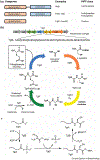Engineering of new-to-nature ribosomally synthesized and post-translationally modified peptide natural products
- PMID: 33556835
- PMCID: PMC8238801
- DOI: 10.1016/j.copbio.2020.12.022
Engineering of new-to-nature ribosomally synthesized and post-translationally modified peptide natural products
Abstract
Natural products have historically been important lead sources for drug development, particularly to combat infectious diseases. Increasingly, their structurally complex scaffolds are also envisioned as leads for applications for which they did not evolve, an approach aided by engineering of new-to-nature analogs. Ribosomally synthesized and post-translationally modified peptides (RiPPs) are promising candidates for bioengineering because they are genetically encoded and their biosynthetic enzymes display significant substrate tolerance. This review highlights recent advances in the discovery of highly unusual new reactions by genome mining and the application of engineering approaches to generate and screen novel RiPP variants. Furthermore, through the use of synthetic biology approaches, hybrid molecules with enhanced or completely new activities have been identified, which opens the door for future advancement of RiPPs as potential next-generation therapeutics.
Copyright © 2021 Elsevier Ltd. All rights reserved.
Conflict of interest statement
conflicts of interest
The authors declare no conflicts of interest
Figures





References
-
- Newman DJ, Cragg GM: Natural products as sources of new drugs over the nearly four decades from 01/1981 to 09/2019. J Nat Prod (2020) 83:770–803. - PubMed
-
- Arnison PG, Bibb MJ, Bierbaum G, Bowers AA, Bugni TS, Bulaj G, Camarero JA, Campopiano DJ, Challis GL, clardy J, Cotter PD et al.: Ribosomally synthesized and post-translationally modified peptide natural products: overview and recommendations for a universal nomenclature. Nat Prod Rep (2013) 30:108–160. - PMC - PubMed
-
-
van Heel AJ, de Jong A, Song C, Viel JH, Kok J, Kuipers OP: BAGEL4: a user-friendly web server to thoroughly mine RiPPs and bacteriocins. Nucleic Acids Res (2018) 46:W278–w281.
• Fourth version of the first bioinformatic tool designed specifically for RiPP discovery.
-
Publication types
MeSH terms
Substances
Grants and funding
LinkOut - more resources
Full Text Sources
Other Literature Sources

